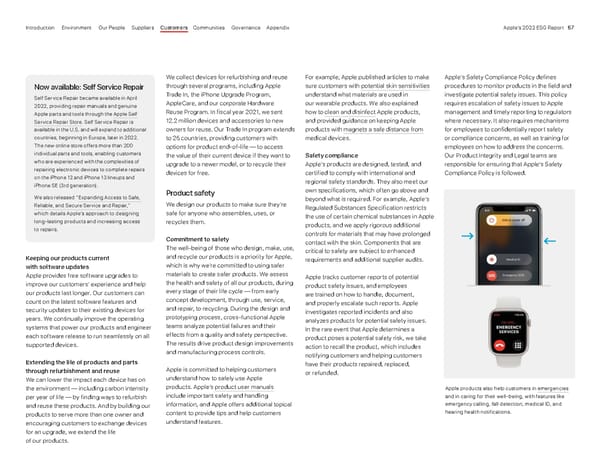Apple’s Safety Compliance Policy defines procedures to monitor products in the field and investigate potential safety issues. This policy requires escalation of safety issues to Apple management and timely reporting to regulators where necessary. It also requires mechanisms for employees to confidentially report safety or compliance concerns, as well as training for employees on how to address the concerns. Our Product Integrity and Legal teams are responsible for ensuring that Apple’s Safety Compliance Policy is followed. We collect devices for refurbishing and reuse through several programs, including Apple Trade In, the iPhone Upgrade Program, AppleCare, and our corporate Hardware Reuse Program. In fiscal year 2021, we sent 12.2 million devices and accessories to new owners for reuse. Our Trade In program extends to 25 countries, providing customers with options for product end-of-life — to access the value of their current device if they want to upgrade to a newer model, or to recycle their devices for free. Product safety We design our products to make sure they’re safe for anyone who assembles, uses, or recycles them. Commitment to safety The well-being of those who design, make, use, and recycle our products is a priority for Apple, which is why we’re committed to using safer materials to create safer products. We assess the health and safety of all our products, during every stage of their life cycle — from early concept development, through use, service, and repair, to recycling. During the design and prototyping process, cross-functional Apple teams analyze potential failures and their effects from a quality and safety perspective. The results drive product design improvements and manufacturing process controls. Apple is committed to helping customers understand how to safely use Apple products. Apple’s product user manuals include important safety and handling information, and Apple offers additional topical content to provide tips and help customers understand features. For example, Apple published articles to make sure customers with potential skin sensitivities understand what materials are used in our wearable products. We also explained how to clean and disinfect Apple products, and provided guidance on keeping Apple products with magnets a safe distance from medical devices. Safety compliance Apple’s products are designed, tested, and certified to comply with international and regional safety standards. They also meet our own specifications, which often go above and beyond what is required. For example, Apple’s Regulated Substances Specification restricts the use of certain chemical substances in Apple products, and we apply rigorous additional controls for materials that may have prolonged contact with the skin. Components that are critical to safety are subject to enhanced requirements and additional supplier audits. Apple tracks customer reports of potential product safety issues, and employees are trained on how to handle, document, and properly escalate such reports. Apple investigates reported incidents and also analyzes products for potential safety issues. In the rare event that Apple determines a product poses a potential safety risk, we take action to recall the product, which includes notifying customers and helping customers have their products repaired, replaced, or refunded. Apple products also help customers in emergencies and in caring for their well-being, with features like emergency calling, fall detection, medical ID, and hearing health notifications. Keeping our products current with software updates Apple provides free software upgrades to improve our customers’ experience and help our products last longer. Our customers can count on the latest software features and security updates to their existing devices for years. We continually improve the operating systems that power our products and engineer each software release to run seamlessly on all supported devices. Extending the life of products and parts through refurbishment and reuse We can lower the impact each device has on the environment — including carbon intensity per year of life — by finding ways to refurbish and reuse these products. And by building our products to serve more than one owner and encouraging customers to exchange devices for an upgrade, we extend the life of our products. Now available: Self Service Repair Self Service Repair became available in April 2022, providing repair manuals and genuine Apple parts and tools through the Apple Self Service Repair Store . Self Service Repair is available in the U.S. and will expand to additional countries, beginning in Europe, later in 2022. The new online store offers more than 200 individual parts and tools, enabling customers who are experienced with the complexities of repairing electronic devices to complete repairs on the iPhone 12 and iPhone 13 lineups and iPhone SE (3rd generation). We also released “ Expanding Access to Safe, Reliable, and Secure Service and Repair ,” which details Apple’s approach to designing long-lasting products and increasing access to repairs. Appendix Governance Communities Suppliers Customers Our People Environment Introduction Apple’s 2022 ESG Report 57
 ESG Report | Apple Page 56 Page 58
ESG Report | Apple Page 56 Page 58